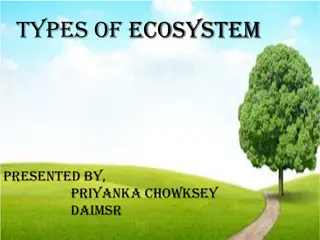Impact of Land Development on Stream Ecosystem Health in Mill Brook Preserve, NY, USA
The study focuses on the effects of land development on stream ecosystem health in the Mill Brook Preserve in New Paltz, NY. It discusses the degradation of water quality due to surrounding land development and the importance of macroinvertebrates as indicators of ecosystem health. The review of literature highlights changes in stream ecosystem health based on land use and the alteration of species composition by land development.
Download Presentation

Please find below an Image/Link to download the presentation.
The content on the website is provided AS IS for your information and personal use only. It may not be sold, licensed, or shared on other websites without obtaining consent from the author.If you encounter any issues during the download, it is possible that the publisher has removed the file from their server.
You are allowed to download the files provided on this website for personal or commercial use, subject to the condition that they are used lawfully. All files are the property of their respective owners.
The content on the website is provided AS IS for your information and personal use only. It may not be sold, licensed, or shared on other websites without obtaining consent from the author.
E N D
Presentation Transcript
THE EFFECT OF LAND DEVELOPMENT ON STREAM ECOSYSTEM HEALTH IN THE MILL BROOK PRESERVE IN NEW PALTZ, NY, USA HOPE NITZA MENTORS: DR. NEIL BETTEZ, MARTHA CHEO
INTRODUCTION The Mill Brook Preserve: - 134-acre nature Preserve in New Paltz - Conserve biodiversity, recreation, education - Tributaries are one of the last undeveloped areas in New Paltz
INTRODUCTION Land Development - Impacts on stream ecosystem health are growing in severity and expansiveness
INTRODUCTION Macroinvertebrates: Key indicator species of stream ecosystem health Mayfly facts: 30 interesting facts you will need for your project. (2021, January 15). Retrieved February 03, 2021, from https://factslegend.org/30-fascinating-mayfly-facts-shouldnt-miss/
REVIEW OF LITERATURE Degradation of water quality in the Mill Brook Preserve as surrounding land development increased (1) Cheo, Martha. 2004. Assessment of the Mill Brook Stream in the Town of New Paltz, New York. Village of New Paltz EnCC and Hudson Basin River Watch. (5) Stolzenburg, AICP, Nan, and Don Meltz, AICP. The Mill Brook Preserve A Plan for Its Creation and Management. (2014, August).Retrieved January 07, 2021, from https://www.townofnewpaltz.org/sites/g/files/vyhlif3541/f/file/file/mill_brook_preserve_management_plan-final_08.28.2014_01.pdf (7) Zeoli, Frank. 2007. Benthic Macroinvertebrate Analysis: Mill Brook Stream, New Paltz, NY. (Fieldwork for Biology 494). State University of New York at New Paltz, New Paltz, NY.
REVIEW OF LITERATURE Stream Ecosystem Health: - Changes in conjunction with surrounding land use impact - Barometer of land use pressures on a watershed (4) Stainbrook, K.M., Limburg, K.E., Daniels, R.A. et al.Long-term changes in ecosystem health of two Hudson Valley watersheds, New York, USA, 1936 2001. Hydrobiologia 571, 313 327 (2006). https://doi.org/10.1007/s10750-006-0254-5 (6) Landers, M. N., Geological Survey (U.S.). (2002). Does land use affect our streams?: a watershed example from Gwinnett County, Georgia, 1998-2001.[Reston, Va.]: U.S. Dept. of the Interior, U.S. Geological Survey.
REVIEW OF LITERATURE - Land development can alter the species composition and distribution of macroinvertebrates - Prime indicators of stream ecosystem health (2) Limburg, K., & Schmidt, R. (1990). Patterns of Fish Spawning in Hudson River Tributaries: Response to an Urban Gradient? Ecology,71(4), 1238-1245. doi:10.2307/1938260 (3) Wallace, J. B., & Webster, J. R. (1996). The role of macroinvertebrates in stream ecosystem function. Annual review of entomology, 41, 115 139. https://doi.org/10.1146/annurev.en.41.010196.000555
HYPOTHESIS There is a negative correlation between the percent of developed land in the watersheds of the Mill Brook Preserve and their stream ecosystem health
METHODOLOGY 3 4 2 1
METHODOLOGY Field study: Macroinvertebrates and Habitat Assessment 1 round per site during September, 2020
METHODOLOGY Biodiversity indices calculated for each sample: EPT Richness Estimate Percent Model Affinity Major Group Biotic Index Mayfly, caddisfly, and stonefly count Compares sample to a model community Calculated using each order s pollution tolerance values
RESULTS Biodiversity Indices
DISCUSSION Habitat Assessment Indices Stream 3 -highest habitat quality 2 streams with lowest % of developed land are least impacted Watershed of stream 3 -lowest percent of developed land (11%) 2 streams with highest % of developed land are most impacted
DISCUSSION Biotic Index and % Developed Land % Model Affinity and % Developed Land R2= 0.146 R2= 0.383 Weak relationship Moderate relationship Negative relationship between percent developed land and stream ecosystem health
DISCUSSION Stream 4 is an anomaly: - 2 Biodiversity scores indicate: - it is less impacted than stream 3 - has a higher percentage of developed land than stream 3
CONCLUSIONS - Negative correlation between the percent of developed land of a watershed and the impact on the stream ecosystem health - Findings support the hypothesis - More research needed to determine cause of the anomaly
REFERENCES (1) Cheo, Martha. 2004. Assessment of the Mill Brook Stream in the Town of New Paltz, New York. Village of New Paltz EnCC and Hudson Basin River Watch. (2) Limburg, K., & Schmidt, R. (1990). Patterns of Fish Spawning in Hudson River Tributaries: Response to an Urban Gradient? Ecology,71(4), 1238- 1245. doi:10.2307/1938260 (3) Wallace, J. B., & Webster, J. R. (1996). The role of macroinvertebrates in stream ecosystem function. Annual review of entomology, 41, 115 139. https://doi.org/10.1146/annurev.en.41.010196.000555 (4) Stainbrook, K.M., Limburg, K.E., Daniels, R.A. et al.Long-term changes in ecosystem health of two Hudson Valley watersheds, New York, USA, 1936 2001. Hydrobiologia 571, 313 327 (2006). https://doi.org/10.1007/s10750-006-0254-5 (5) Stolzenburg, AICP, Nan, and Don Meltz, AICP. The Mill Brook Preserve A Plan for Its Creation and Management. (2014, August). Retrieved January 07, 2021, from https://www.townofnewpaltz.org/sites/g/files/vyhlif3541/f/file/file/mill_brook_preserve_management_plan-final_08.28.2014_01.pdf (6) Landers, M. N., Geological Survey (U.S.). (2002). Does land use affect our streams?: a watershed example from Gwinnett County, Georgia, 1998- 2001.[Reston, Va.]: U.S. Dept. of the Interior, U.S. Geological Survey. (7) Zeoli, Frank. 2007. Benthic Macroinvertebrate Analysis: Mill Brook Stream, New Paltz, NY. (Fieldwork for Biology 494). State University of New York at New Paltz, New Paltz, NY. (8) USA NLCD Land Cover. (2019, June 5). ArcGIS Online. (9) Behar, S., & Cheo, M. (2004). Hudson Basin River Watch Guidance Document: Helping to coordinate monitoring of freshwater wadeable rivers throughout the watershed. Retrieved January 07, 2021, from http://www.communityscience.org/wp-content/uploads/2017/05/HBRWGD04.pdf























